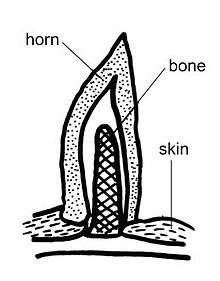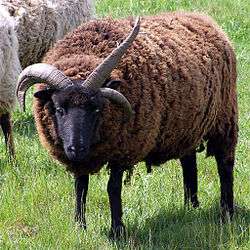Horn (anatomy)


A horn is a permanent pointed projection on the head of various animals consisting of a covering of keratin and other proteins surrounding a core of live bone. Horns are distinct to antlers which are not permanent. In mammals, true horns are found mainly among the ruminant artiodactyls, in the families Antilocapridae (pronghorn) and Bovidae (cattle, goats, antelope etc.).
One pair of horns is usual; however, two or more pairs occur in a few wild species and domesticated breeds of sheep. Polycerate (multi-horned) sheep breeds include the Hebridean, Icelandic, Jacob, Manx Loaghtan, and the Navajo-Churro.
Horns usually have a curved or spiral shape, often with ridges or fluting. In many species only males have horns. Horns start to grow soon after birth, and continue to grow throughout the life of the animal (except in pronghorns, which shed the outer layer annually, but retain the bony core). Partial or deformed horns in livestock are called scurs. Similar growths on other parts of the body are not usually called horns, but spurs, claws or hoofs depending on the part of the body on which they occur.
Other hornlike growths
The term "horn" is also popularly applied to other hard and pointed features attached to the head of animals in various other families:
- Giraffidae: Giraffes have one or more pairs of bony bumps on their heads, called ossicones. These are covered with furred skin.
- Cervidae: Most deer have antlers, which are not true horns. When fully developed, antlers are dead bone without a horn or skin covering; they are borne only by adults (usually males, except for reindeer) and are shed and regrown each year.
- Rhinocerotidae: The "horns" of rhinoceroses are made of keratin, the same substance as fingernails, and grow continuously, but do not have a bone core.
- Chamaeleonidae: Many chameleons, most notably the Jackson's Chameleon, possess horns on their skulls, and have a keratin covering.
- Ceratopsidae: The "horns" of the Triceratops were extensions of its skull bones although debate exists over whether they had a keratin covering.
- Horned lizards (Phrynosoma): These lizards have horns on their heads which have a hard keratin covering over a bony core, like mammalian horns.
- Insects: Some insects (such as rhinoceros beetles) have horn-like structures on the head or thorax (or both). These are pointed outgrowths of the hard chitinous exoskeleton. Some (such as stag beetles) have greatly enlarged jaws, also made of chitin.
- Canidae: Golden jackals are known to occasionally develop a horny growth on the skull, which is associated with magical powers in south-eastern Asia.[1][2]
Many mammal species in various families have tusks, which often serve the same functions as horns, but are in fact oversize teeth. These include the Moschidae (Musk deer, which are ruminants), Suidae (Wild Boars), Proboscidea (Elephants), Monodontidae (Narwhals) and Odobenidae (Walruses). Polled animals or pollards are those of normally-horned (mainly domesticated) species whose horns have been removed, or which have not grown. In some cases such animals have small horny growths in the skin where their horns would be – these are known as scurs.
On humans
Cutaneous horns are the only examples of horns growing on people. They are most often benign growths and can be removed by a razor.
Cases of people growing horns have been historically described, sometimes with mythical status. Researchers have not however discovered photographic evidence of the phenomenon.[3] There are human cadaveric specimens that show outgrowings, but these are instead classified as osteomas or other excrescences.[3]
The phenomenon of humans with horns has been observed in countries lacking advanced medicine. There are living people, several in China, with cases of cutaneous horns, most common in the elderly.[4]
Some people, notably The Enigma, have horn implants; that is, they have implanted silicone beneath the skin as a form of body modification.[5]
The erect penis is sometimes referred to in slang use as a "horn", but it normally contains no keratin. However, a cutaneous horn can grow on the penis, which may indicate cancer.[6]
Animal uses of horns
.jpg)

Animals have a variety of uses for horns and antlers, including defending themselves from predators and fighting members of their own species (horn fighting) for territory, dominance or mating priority.[7][8] Horns are usually present only in males but in some species, females too may possess horns. It has been theorized by researchers that taller species living in the open are more visible from longer distances and more likely to benefit from horns to defend themselves against predators. Female bovids that are not hidden from predators due to their large size or open savannah like habitat are more likely to bear horns than small or camouflaged species.[9]
In addition, horns may be used to root in the soil or strip bark from trees. In animal courtship many use horns in displays. For example, the male blue wildebeest reams the bark and branches of trees to impress the female and lure her into his territory. Some animals with true horns use them for cooling. The blood vessels in the bony core allow the horns to function as a radiator.
After the death of a horned animal the keratin may be consumed by the larvae of the Horn Moth.
Human uses of horns
- Horned animals are sometimes hunted so their mounted head or horns can be displayed as a hunting trophy or as decorative objects.
- Some cultures use bovid horns as musical instruments, for example the shofar. These have evolved into brass instruments in which, unlike the trumpet, the bore gradually increases in width through most of its length—that is to say, it is conical rather than cylindrical. These are called horns, though now made of metal.
- Drinking horns are bovid horns removed from the bone core, cleaned and polished and used as drinking vessels. (See also the legend of the Horn of plenty, or Cornucopia). It has been suggested that the shape of a natural horn was also the model for the rhyton, a horn-shaped drinking vessel.[10]
- Powder horns were originally bovid horns fitted with lids and carrying straps, used to carry gunpowder. Powder flasks of any material may be referred to as powder horns.
- Shoehorns were originally made from slices of bovid horn, which provided the right curving shape and a smooth surface.
- Antelope horns are used in traditional Chinese medicine.
- Horns consist of keratin, and the term "horn" is used to refer to this material, sometimes including similarly solid keratin from other parts of animals, such as hoofs. Horn may be used as a material in tools, furniture and decoration, among other uses. In these applications, horn is valued for its hardness, and it has given rise to the expression hard as horn. Horn is somewhat thermoplastic and (like tortoiseshell) was formerly used for many purposes where plastic would now be used. Horn may be used to make glue.
- Horn bows are bows made from a combination of horn, sinew and usually wood. These materials allow more energy to be stored in a short bow than wood alone.
- Horns and horn tips from various animals have been used for centuries in the manufacture of scales, grips, or handles for knives and other weapons, and beginning in the 19th century, for the handle scales of handguns.
- Ivory comes from the teeth of animals, not horns.
- "Horn" buttons are usually made from deer antlers, not true horn.
Gallery
 Erkencho, musical instrument of horn
Erkencho, musical instrument of horn
.jpg) Water buffalo horn (Bubalus bubalis)
Water buffalo horn (Bubalus bubalis)
See also
- Horn (disambiguation)
- French horn
- Horned helmet
- Polled livestock
- Tortoiseshell material
- Shofar
- longhorns
References
- ↑ Sketches of the natural history of Ceylon by Sir James Emerson Tennent, published by Longman, Green, Longman, and Roberts, 1861
- ↑ Mammals of Nepal: (with reference to those of India, Bangladesh, Bhutan and Pakistan) by Tej Kumar Shrestha, published by Steven Simpson Books, 1997, ISBN 0-9524390-6-9
- 1 2 Tubbs, R. Shane; Smyth, Matthew D.; Wellons, John C. III; Blount, Jeffrey P.; Oakes, W. Jerry (June 2003). "Human horns: a historical review and clinical correlation". Neurosurgery. 52 (6): 1443–1448. doi:10.1227/01.NEU.0000064810.08577.49. PMID 12762889. (Literature Reviews)
- ↑ [DEAD LINK! http://www.stern.de/wissen/mensch/ungewoehnliche-operation-aerzte-befreien-frau-von-horn-1682189.html "Bundestagswahl 2013"] Check
|url=value (help). - ↑ Johann, Hari (2002-03-11). "Johann Hari on the bizarre world of radical plastic surgery". London: Guardian News and Media. Retrieved 2010-05-04.
- ↑ "Cutaneous horn of the penis: Its association with squamous cell carcinoma and HPV-16 infection".
- ↑ Valerius Geist; Fritz R. Walther; International Union for Conservation of Nature and Natural Resources (1974). The Behaviour of Ungulates and Its Relation to Management: The Papers of an International Symposium Held at the University of Calgary, Alberta, Canada, 2-5 November 1971. International Union for Conservation of Nature and Natural Resources.
- ↑ Edward O. Wilson (1 January 1980). Sociobiology. Harvard University Press. pp. 119–. ISBN 978-0-674-81624-4.)
- ↑ "Why Female Water Buffalo Have Horns but Impala Do Not?".
- ↑ Chusid, Hearing Shofar: The Still Small Voice of the Ram's Horn, 2009, Chapter 3-6 - Ram's Horn of Passover <http://www.hearingshofar.com>. The book also posits that the ancient Hebrews and neighboring tribes used horns as weapons and as utensils.
External links
| Wikimedia Commons has media related to Animal horns. |